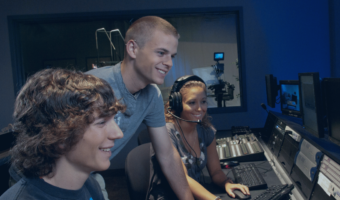Program Overview

The Graphic Design associate degree program prepares students for entry-level positions in visual media production environments. The program fosters creativity, marketing, and design with technical agility. Our coursework allows students to generate a wide-range of portfolio-ready projects for print, screen, or web. From day one, students will begin the practice of design principles and design thinking. Their visual acuity will grow through the use of digital cameras, Adobe tools, and web content management systems.
Upon completion of the Associate in Science degree in Graphics Design, students will have the opportunity to matriculate into the challenging and rewarding Bachelor of Science in Graphic Design.
Read More The Graphic Design associate degree program prepares students for entry-level positions in a variety of emerging media and desktop production environments. The underlying goal of visual creativity is central to all of the technological coursework, and each student will produce and design a personal “brand” to package and promote their online portfolios. Starting with the core skills of digital photography, design, and computer graphics, students receive hands-on, project-oriented instruction in website design, graphic design, e-publishing, interactive digital multimedia, branding, and typography. A wide variety of industry standard software is used. Upon completion of the Associate in Science degree in Graphic Design, students will have the opportunity to matriculate to the Bachelor of Science degree in Graphic Design.Full Description
Potential Career Opportunities
Our associate degree program in Graphic Design will introduce graduates to plenty of graphic design positions and related job opportunities. Individuals will be qualified to pursue positions across the design industry such as:
Website Designer
Graphic Designer
Multimedia Designer
Photographer
UI/UX Designer
Production Artist
Packaging Designer
FAQ
-
What can you do with an associate degree in graphic design?
Individuals with an associate degree in graphic design can pursue a number of different career options. A graduate of graphic design degree programs may work as a multimedia designer, multimedia artist, production artist, or graphic design artist. Professionals in these fields remain in high demand.
-
Is graphic design a good career?
If you are interested in graphic design, then a career in Digital Media and Graphic Design is a great option to pursue. Multimedia designers are able to entertain different career options across a variety of industries, from public relations, film and television, animation, video game production and more.
-
What is a design degree?
Design degrees will introduce students to both creative and technical skills to prepare them to join the workforce. Degree programs provide the experience needed to pursue a career in web development, computer programming languages, digital imaging, drafting, art and animation.



